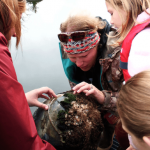Very few juvenile salmon return to spawn. Many are consumed by larger fish that eat them as they migrate from rivers or hatcheries to the ocean.
That’s a problem for hatcheries that release millions of young salmon, called smolts, into the waters of coastal Alaska. Alaska Sea Grant funded Anne Beaudreau’s research on chum salmon predation by two common nearshore fish species, Dolly Varden and staghorn sculpin. Beaudreau is a faculty member in the College of Fisheries and Ocean Sciences.
The researchers, including University of Alaska Fairbanks student Douglas Duncan, found that both predators consumed lots of chum salmon. In fact, their stomachs were consistently full with a variety of items, including salmon.
For his master’s degree, Duncan spent three years studying whether the release of hatchery fish can act as a “dinner bell,” attracting predators to release sites. Duncan concluded that Dolly Varden and sculpin were abundant at a variety of times, not just when hatchery salmon were released.
But neither species is the “smoking gun” of salmon mortality at marine entry, Duncan found. There are likely many challenges to salmon during their marine phase and more work is needed on this important, but less understood, part of their life cycle.
The private nonprofit salmon hatchery, Douglas Island Pink and Chum (DIPAC), helped support this project.







